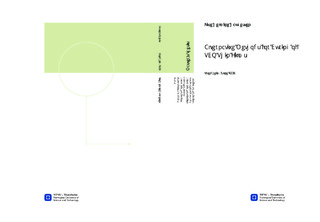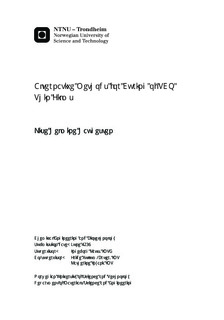| dc.description.abstract | Transparent conducting oxides have a unique combination of properties as they are both optical transparent in the visible region of the electromagnetic spectrum, and obtain a near-metallic conductivity. This makes them extensively used in a wide variety of technological applications. The industrial demand for developing better, cheaper, and faster methods for producing these materials is increasing continuously. Thus, the motivation for this master thesis is to find a cheaper and faster way to produce transparent conductive oxides while still retaining the optoelectronic properties. A possible way of doing this is by replacing the conventional furnace heat-treatment step of sol-gel derived transparent conductive oxides with photochemical activation. The aim of this work is hence to compare the quality of sol-gel derived indium tin oxide and indium zinc oxide thin films cured using thermal and ultraviolet radiation methods.Indium tin oxide and indium zinc oxide thin films were prepared by spin coating a sol synthesized by an environmental friendly Pechini method onto glass and silicon substrates. The thin films were subsequently characterized with respect to crystal structure, morphology, optical properties, and electrical properties.The thermally cured indium tin oxide and indium zinc oxide thin films obtained a non-directional phase pure cubic bixbyite crystal structure, while the ultraviolet curing at room temperature and 150 °C gave an amorphous structure. By studying the morphology of the thin films it could be observed that the thermal curing gave the highest homogeneity, while the ultraviolet curing at 150 °C gave the lowest homogeneity. The same trend was also found for surface roughness, where the lowest roughness was obtained for the thermally cured films. The thin films obtained a high optical transparency with an average value of 88-97 % in the visible region of the electromagnetic spectrum. No clear trend could be seen with regards to the effect of the different curing methods on the absolute value of the transparency, whereas an evident trend was seen for the curve shape. The transmission curves had an absorption band edge at about 300 nm, and a band gap of 3.8 eV and 3.7 eV was observed for indium tin oxide and indium zinc oxide, respectively. The optical constants refractive index and extinction coefficient indicates a difference in the optical properties for indium tin oxide and indium zinc oxide. For the thermally cured indium tin oxide thin films the lowest resistivity values obtained on glass and silicon substrates were 2.8×10-3 Ω cm and 2.2×10-3 Ω cm, respectively, while the lowest resistivity values obtained for the indium zinc oxide thin films on glass and silicon substrates were 0.4 Ω cm and 0.1 Ω cm, respectively. It was not possible to obtain resistivity measurements for any of the ultraviolet curing methods, indicating that these films are non-conducting. This is most likely due to incomplete decomposition of organics in the thin films. | nb_NO |

